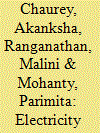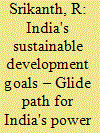|
|
|
Sort Order |
|
|
|
Items / Page
|
|
|
|
|
|
|
| Srl | Item |
| 1 |
ID:
052294


|
|
|
|
|
| Publication |
Oct 2004.
|
| Summary/Abstract |
The purpose of this paper is to weigh the issues and options for increasing electricity access in remote and geographically challenged villages in interior Rajasthan, the desertstate in Western India where power sector reforms are currently underway. By first providing an overview of reforms and various electrification policy initiatives in India, the paper then analyzes the specific problems as studied at the grass-roots level with respect to rural electricity access and the use of off-grid renewables. Finally, it discusses interventions that could facilitate access to electricity by suggesting a sequential distributed generation (DG)-based approach, wherein consecutive DG schemes-incorporating the requisite technological, financial, and institutional arrangements-are designed depending on the developmental requirements of the community. In essence, this approach fits under the broader need to understand how the three "Rs"- rural electrification (the process), power sector reforms (the catalyst), and the use of renewable energy technologies (the means)-could potentially converge to meet the needs of India's rural poor.
|
|
|
|
|
|
|
|
|
|
|
|
|
|
|
|
| 2 |
ID:
099323


|
|
|
|
|
| Publication |
2010.
|
| Summary/Abstract |
When grand institutional reforms based on idealized models are stalled by the poor institutional environments and difficult politics which often surround large infrastructure systems in developing countries, partial reforms whose design and implementation take into account the different interests of the key stakeholders can provide valuable and immediate benefits while moving these systems from low- towards higher-level equilibria. Strategically negotiated, experimentally partial and purposefully hybrid, these reforms are based on careful stakeholder analysis and strategic coalition building that avoid rigid positions based on idealized models. Our findings are based on a study of power sector reforms in India, where we performed a micro-level and in-depth analysis of a partial and innovative experiment which has allowed private sector participation in electricity distribution within a hostile institutional environment.
|
|
|
|
|
|
|
|
|
|
|
|
|
|
|
|
| 3 |
ID:
162307


|
|
|
|
|
| Summary/Abstract |
India has adopted the 2030 Agenda during the United Nations Summit held in September 2015. Energy is intimately connected with 74% of the 169 targets related to the 17 Sustainable Development Goals (SDGs) to be achieved by 2030. Subsequently, India has also submitted its Nationally Determined Contributions (NDCs) for the period 2021–2030 to the United Nations Framework Convention on Climate Change (UNFCCC). While the Government of India (GOI) has ambitious plans for enhancing the installed capacity of RE sources, 75% of its electricity is currently generated by coal-fired power plants. As India's electricity requirements grow to meet the aspirations of 1.3 Bi people, it needs a policy framework that integrates all low-carbon energy technologies with coal in such a manner that the reliability, security, and affordability of electric supply are balanced with sustainable development. India also needs to develop innovative strategies to clean up the country's coal sector while enhancing the integration of renewable energy into the National Power Grid. In this context, certain recommendations are proposed in this article for timely implementation by GOI to facilitate the achievement of India's targets with respect to SDG 7 and the NDCs in an efficient and effective manner.
|
|
|
|
|
|
|
|
|
|
|
|
|
|
|
|
| 4 |
ID:
180166


|
|
|
|
|
| Summary/Abstract |
Many countries have undertaken market-oriented reforms of the power sector over the past four decades. However, the literature has not investigated whether the reforms have contributed to economic growth. This study assesses the potential macroeconomic impacts of following the market-based principle in operating and expanding the power system, an important ingredient of the power sector reform launched in China in 2015. The study uses a hybrid modeling approach by coupling a top-down computable general equilibrium model with a bottom-up energy sector TIMES model. The study finds that electricity prices in China would be 20 percent lower than the country is likely to experience in 2020 if the country follows the market principle to expand and operate the power system. The price reduction would spill over throughout the economy, resulting in an increase in the gross domestic product of more than one percent (or more than a billion US dollars) in 2020. It would also have positive impacts on most economic indicators, including household income and international trade. The findings quantitatively highlight the importance of implementing the 2015 power sector reforms in China and further expanding the initiatives in the future.
|
|
|
|
|
|
|
|
|
|
|
|
|
|
|
|
| 5 |
ID:
177109


|
|
|
|
|
| Summary/Abstract |
Energy is a key component for economic growth as well as for human development. India is the third-ranking electricity generator in the world but ranks 106th in terms of per capita consumption. Specifically, the distribution of power is the most important link in the value chain of the power sector since it is the cash register for the entire sector. In India, electricity is a concurrent subject shared between the Central and State Governments. While the generation of power has been deregulated since 2003, the supply of power to the consumers is generally carried out by Government-owned power Distribution Companies (DISCOMs). In this paper, the authors analyze the financial distress of DISCOMs in India, and explain how the supply-demand mismatch due to over-ambitious demand projections, the fixed and energy charges of thermal power plants, and the excess procurement of “must-run” renewable sources together contribute to the high cost of power procurement that drives the financial stress faced by DISCOMs. The authors support their assertion with a study of nine DISCOMs supplying electricity to 155 million people in three States and propose policy recommendations for a turnaround of such DISCOMs which can be rolled out with suitable modifications across India.
|
|
|
|
|
|
|
|
|
|
|
|
|
|
|
|
|
|
|
|
|